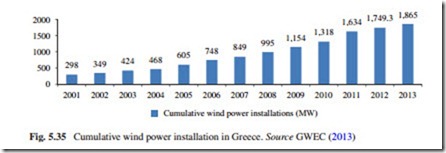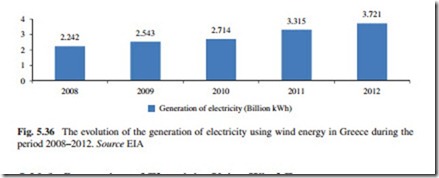Greece
According to Zervos and Kjaer (2008), hydropower has traditionally been an important energy source in Greece, and the markets for wind energy and active solar thermal systems have grown in recent years. The Greek parliament has recently revised the renewable energy policy framework, partly to reduce administrative burdens on the renewable energy sector.
General policies relevant to renewable energy sources include a measure related to investment support, a 20 % reduction of taxable income on expenses for domes- tic appliances or systems using renewable energy sources, and a concrete bidding procedure to ensure the rational use of geothermal energy. In addition, an inter- ministerial decision was taken in order to reduce the administrative burden associated with renewable energy installations.
Greece has introduced the following mechanisms to stimulate the growth in the use of renewable energy sources for the generation of electricity:
• FiTs were introduced in 1994 and amended by the recently approved Feed-in Law. Tariffs are now technology specific, instead of uniform, and a guarantee of 12 years is given, with a possibility of extension for up to 20 years;
• Liberalization of renewable energy sources for the generation of electricity development.
At the end of 2013, the wind power capacity installed in the country reached 1,865 MW and represents an increase of 6.7 % with respect to 2012. During the past 13 years, the installed wind power capacity increased in each one of them (see Fig. 5.35). The major increase in wind power capacity was reported in 1999 with respect to 1998 (187.3 %). The number of wind farms in Greece reached 139 in 2014.
Greece’s wind energy sector showed signs of investment recovery during the second half of 2013, despite the adverse conditions, according to the Hellenic Wind Energy Association sources. At regional level, central Greece remains on top of wind installations, it said. Total net wind power installed between June and December 2013 was 71.15 MW, nearly twice the power of the previous six- month period (44.05 MW) and seven times the strength of the corresponding
period of 2012 (10.35 MW). This means the wind energy market grew 7.93 % in the last half of 2013, while annual growth was 7.05 %.
According to EWEA (2011), Greece has a binding renewable target of 18 % by 2020, up from 6.9 % in 2005; this represents an increase of 11.1 %. The Greek authorities have planned to overshoot the target by over 2 %. To reach the overall target, the approved NREAP focuses on the power sector. Almost 40 % of electric- ity consumption is forecast to be met by renewable in 2020. Onshore and offshore wind power should represent the lion’s share of the renewable power market and are forecast to meet 24.5 % of the country’s electricity consumption in 2020. To achieve this, the action plan banks on reaching 7.5 GW of total installed wind capacity, of which 300 MW of offshore installations, by 2020. The net annual increase in wind power capacity is expected to be constant at around 600 MW. Offshore deployment is not expected to start before 2016 and is projected to grow consistently by 50 MW a year. In 2020, offshore build-out is expected to increase to 100 MW.
The Greek forecasts for wind capacity and share of the power mix are in line with EWEA’s scenarios. The wind energy targets for 2020 are included in Table 5.22.
According to Gkarakis et al. (2009), the Regulatory Authority of Energy declared through its President of the 4th Conference of HWEA that the Greek national elec- tric system could absorb the penetration of 5,500 MW wind energy capacity without any problem of reliability and stability. This capacity could be increased to 6,000 or 6,200 MW, if it calculated the wind farms in non-interconnected islands.
Not all these targets for wind energy exploitation are specialized for onshore or offshore installations. One of the main constraints for the development of the off- shore15 wind energy plants in Greece is the availability of onshore sites with high potential. Another barrier is that the depth of the Greek seas in combination with military and environmental limitations. In addition, the complexity of the licensing procedure to obtain the required permissions and authorizations for the development of offshore wind farms could be another factor that would limit the expansion of the wind sector during the coming years.
Generation of Electricity Using Wind Energy
The evolution of the generation of electricity using wind energy in Greece during the period 2008–2014 is shown in Fig. 5.36. According to that figure, the generation of electricity using wind power in Greece during the period 2008–2012 increased 65.9 %. On the basis of the decision taken by the government, it is expected that the generation of electricity using wind energy in Greece will continue increasing during the coming years.
Finally, it is important to highlight the following: A significant amount of capital is required in order to build the physical plant that is used to convert the kinetic energy of wind into electrical energy. In the case of wind farms, the cost of instal- lation and construction is the largest portion of lifetime cost. Once the plant has been built, the only running costs are the interest on the capital that was used to finance the plant’s construction and the operation and maintenance. While thermal plants face a higher lifetime outlay for fuel, wind plants get their fuel for free.
The initial investment cost for a wind park includes not only the cost of purchasing a turbine, but also the cost of installing the associated infrastructure, as well as the cost of connecting the park to the grid. Depending on the generation capacity of the wind park, the connection cost could include the construction of a substation to manage the influx of electric power to the transmission grid. The connection cost is of the order of €40,000–€50,000 per MW of substation capacity. Wind power plants throughout the world often suffer from the fact that areas of high wind capacity are not always close to areas of high electricity demand. This is also the case in Greece. Constructing the power lines between the existing grid and the wind power plant’s potential site adds a significant cost. This is especially true for wind farms located on the Greek islands, which will have to absorb the higher costs of a connection via the sea (Vlahakis 2010).


